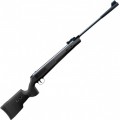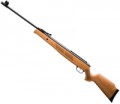Muzzle velocity
The muzzle velocity provided by the rifle - that is, the speed of the bullet as it exits the barrel.
All other things being equal, a higher bullet speed provides greater range and accuracy, and also simplifies aiming at long distances: the bullet flies along a smoother trajectory and requires fewer adjustments in height, and the influence of side winds decreases with increasing speed. On the other hand, this indicator directly affects the price of the rifle; and in some countries, legal restrictions on the ownership of pneumatic weapons are also related to the muzzle velocity of the bullet.
As for specific values, in the weakest modern rifles the initial speed does not exceed
150 m/s, and in the most powerful it can be
300 - 350 m/s or even
more(remember, the speed of sound is 330 m/s). In general, for recreational shooting at short distances, this parameter is not particularly important, and detailed recommendations for choosing pneumatics for more specific situations can be found in special sources. Let us only note that in AEG electric drives (see “Type”) the initial speed extremely rarely exceeds 150 m/s, but this is done solely for safety reasons: such “weapons” are intended for military-tactical games and initially involve shooting at people, and the high speed would be unsafe for players even with protective equipment.
It is also wor
...th considering that this indicator is not strictly defined. In any type of pneumatic it depends on the weight of the bullet (the lighter the faster); therefore, in the characteristics it is usually customary to indicate a certain average velocity for standard ammunition (usually weighing 0.5 g, in AEG - 0.2 g). In addition, in multi-compression rifles the actual speed of the bullet is determined by the degree of inflation, in gas-cylinder rifles it is determined by the ambient temperature, and in PCP models it is possible to achieve higher speeds than declared by replacing the air with a special gas (for example, helium). Nevertheless, this characteristic makes it possible to evaluate the capabilities of the rifle and compare it with other models, including those that differ in type.Adjustable trigger
The ability to adjust the features of the trigger triggering of the rifle — first of all, the idle (before triggering) stroke of the trigger and the force on the hook. This allows you to optimally adjust the characteristics of the weapon to the personal preferences of everyone: for example, it is usually difficult for beginners to shoot with a tight trigger, but for trained shooters, a too soft hook that “falls through” under the finger may be inconvenient.
Cheek adjustment
The ability to adjust the location of the emphasis under the cheek, located on the butt. Usually, we are talking about at least height adjustment, and in advanced models it may also be possible to move the stop back and forth. Anyway, this feature allows you to adjust the position of the cheek to the physique and personal preferences of a particular shooter, thus providing the most comfortable tab — and this convenience, in turn, has a positive effect on accuracy. At the same time, the ability to
adjust the cheekpiece significantly increases the price of the rifle, and therefore it is found mainly in top-class models.
Stock material
—
Tree. A classic material used in firearms and then pneumatic weapons since ancient times (in fact, since its inception). Wooden stocks are strong enough on their own, and in modern rifles they are also amenable to special treatment to protect against dampness, temperature changes, etc .; while the rifles have a nice appearance in a classic style. At the same time, the wood is prone to abrasion, scratches easily appear on it, and there is a possibility of cracks. When used in simple conditions, such as periodic "shooting" in the country, this does not matter, however, for example, a wooden stock is not suitable for hunting — at least because it will quickly lose its "presentation". At the same time, this material is also somewhat more expensive and more difficult to process than plastic that is more resistant to “troubles”. Therefore, today the tree is used mainly in pneumatics of the middle and upper price range and is designed for those who are primarily interested in the aesthetics of weapons.
—
Plastic. One of the most popular materials for the manufacture of modern pneumatics. Such stocks are easy to manufacture and inexpensive, while the plastic can be given a rather complex shape without any problems, which, in particular, facilitates the installation of various adjustment systems (see “Cheek Adjustment”, “Butt / Stock Adjustment”). However, its main advantage is practicality: this materia
...l is resistant to impacts, cracks and scratches, comparable in strength to wood (or even superior) and has a small weight. As a result, plastic has become widespread in almost all price ranges.
— Aluminium. A fairly advanced material that combines low weight and high strength. On the other hand, aluminium stocks for classic pneumatics are generally expensive, and therefore are used mainly in high-end professional models (although there are exceptions). But in airsoft rifles that copy real weapons, the situation is somewhat different: there aluminium can be used as a simpler and more affordable alternative to steel (from which gunshot prototypes are made).
